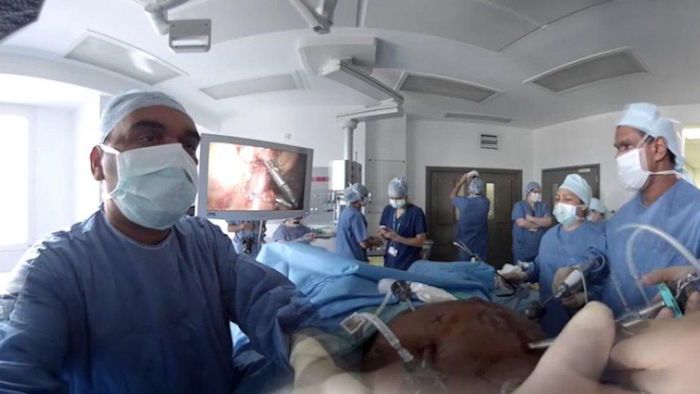Replicas of famous paintings are routinely created with printers that use only four inks – cyan, magenta, yellow, and black. RePaint, a new technique developed at MIT, combines artificial intelligence, 3D printing, and a rich 10-ink palette for much more faithful results in any lighting condition.
Get the latest international news and world events from around the world.

Researchers Turn Lobster Shells Into Biodegradable Plastic
Plastic is a resilient and versatile material, but it’s not that great for the environment — not plastic that’s made from petroleum, anyway. But scientists are cooking up a better alternative.
Chitin, like plastic, is resilient and versatile. Chitin is found in everything from lobster and shrimp shells, insect exoskeletons, and squid beaks. Thanks to a team of Canadian researchers it may soon be found in plastic, too.
Scientists at McGill University in Montreal have developed a process that allows them to process chitinous things into eco-friendly plastic. Associate Professor of Applied Chemistry Audrey Moores told the CBC “it remains biodegradeable, so if it goes in the environment it’s not going to pollute.”
In a galaxy far away, an old star exploded and became a supernova
About 170 million years later, the light emanating from the explosion was received by an arsenal of high-powered telescopes here at Earth. While the telescopes observed, a few of those stars ended their long lives in dramatic explosions. See what we learned: https://go.nasa.gov/2rcIaOr&h=AT2ywbQrtay_XNW6uqmtoFtsirkvbj…cfHXkJ10lQ

Ira Pastor — IdeaXme — Longevity Ambasador
Very excited to join IdeaXme (http://radioideaxme.com/) as Longevity Ambassador, utilizing this wonderful media platform to help expand global awareness of the people engineering a future free of aging, disease, degeneration, and suffering.

This dark
This dark, tangled web spotted by NASA’s Hubble Space Telescope is a supernova remnant, created after a massive star ended its life in an explosion and threw its constituent material out into surrounding space. Discover more: https://go.nasa.gov/2G0nVgS&h=AT0m92-1V7h2Z6pdebGy-JSLFW…CsgI5QIBpg

Russia Announces Plans to Establish Moon Colony by 2040
The first stage foresees the launch of a module to orbit the moon, the RBC news website reported, citing Nikolai Sevastyanov, the head of Russia’s TsNIIMash federal rocket and spaceсraft development corporation.
The second phase will reportedly involve sending the country’s first manned mission to the moon and starting construction of a long-term base between 2025 and 2034. The program’s third stage envisions the completion of the base’s construction by 2040 and the establishment of an “integrated manned moon exploration system.”
Construction of the moon colony is set to begin late in 2025, the state-run RIA Novosti news agency cited Yevgeny Mikrin, Russia’s chief designer of manned space programs, as saying during a presentation of the draft lunar program on Wednesday.

Tesla will live and die by the Gigafactory
Right now, in the desert just east of Reno, Nevada, Tesla is drilling into recently laid asphalt to install more electric vehicle chargers in the parking lot of the Gigafactory. The company has hired so many new workers in recent years that it needs more space to let them charge their Nissan Leafs, Chevy Bolts, Toyota Priuses, and, of course, Teslas. But before long, those chargers will be ripped right back out, along with the asphalt, and moved to a new spot to make room for more factory space.

Using Artificial Intelligence to fix healthcare
Surgery filmed in 360° and live-streamed to remote doctors could already be happening in a hospital near you.
The healthcare industry should be using Artificial Intelligence (AI) to a far greater degree than at present, but progress has been painfully slow. The same factors that make the healthcare system so attractive to AI developers – fragmented or non-existent data repositories, outdated computer systems and doctor shortages – are the same things that have stopped AI from providing the gains that should be created.
The healthcare sector also presents unique obstacles for AI: data must flow freely through AI systems to achieve real results, but extracting data from handwritten patient files or PDFs is cumbersome for us, and difficult for AI. Despite technical and operational challenges, new research suggests that the arrival of the tech giants into the industry may provide the data and the capital required to digitize this fairly untapped market.

We could move to another planet with a spaceship like this
Proxima b, our nearest neighboring exoplanet, is almost 25 trillion miles away. Even one of our fastest spaceships—the 31,600-mile-per-hour New Horizons—would take hundreds of thousands of years to get there. Assuming we can’t figure out how to warp space-time (seems unlikely, but fingers crossed), we’re still looking at a couple-hundred-year trip in the best-case scenario, which leads to the real problem: No human crew could survive the entire ride. Science-fiction writers have long floated so-called generation ships as a solution. Designers would outfit these interplanetary cruise vessels to support a community of adults and their children, and their children’s children, and their children’s children’s children…until humanity finally reaches a new celestial shore. Here’s our best guess for what it would take to sow the seeds of an extrasolar species.
Career planning
Successive generations need to fill all the vital crew roles—such as medics and mechanics—which doesn’t leave much room for freedom of choice. A version of modern career tests would assign occupations based on aptitude, passions, and available jobs.

Physicists finally calculated where the proton’s mass comes from
A proton’s mass is more than just the sum of its parts. And now scientists know just what accounts for the subatomic particle’s heft.
Protons are made up of even smaller particles called quarks, so you might expect that simply adding up the quarks’ masses should give you the proton’s mass. However, that sum is much too small to explain the proton’s bulk. And new, detailed calculations show that only 9 percent of the proton’s heft comes from the mass of constituent quarks. The rest of the proton’s mass comes from complicated effects occurring inside the particle, researchers report in the Nov. 23 Physical Review Letters.
Quarks get their masses from a process connected to the Higgs boson, an elementary particle first detected in 2012 (SN: 7/28/12, p. 5). But “the quark masses are tiny,” says study coauthor and theoretical physicist Keh-Fei Liu of the University of Kentucky in Lexington. So, for protons, the Higgs explanation falls short.